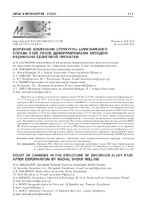Изучение изменения структуры циркониевого сплава Э125 после деформирования методом радиально-сдвиговой прокатки

Date
2023Publisher
Another Title
Study of changes in the structure of zirconium alloy E125 after deformation by radial shear rolling
Bibliographic entry
Изучение изменения структуры циркониевого сплава Э125 после деформирования методом радиально-сдвиговой прокатки = Study of changes in the structure of zirconium alloy E125 after deformation by radial shear rolling / М. К. Магжанов [и др.] // Литье и металлургия. – 2023. – № 2. – С. 111-118.
Abstract
Проведено исследование реологических свойств сплава Э125 (Zr‑2,5 % Nb) в диапазоне скоростей деформации 0,5– 15 с‑1 и температур 20–770 °C. В указанных температурно-скоростных диапазонах была создана база данных для компьютерного МКЭ-моделирования. В программном пакете DEFORM‑3D с использованием полученной базы данных проведено численное моделирование сложного процесса радиально-сдвиговой прокатки. Определены условия, способствующие измельчению структуры сплава в ультрамелкозернистое состояние. По результатам моделирования выполнен натурный эксперимент прокатки прутка из сплава Э125 на стане радиально-сдвиговой прокатки РСП‑14/40 за семь проходов с диаметра 37 до 20 мм с общим обжатием по диаметру ε = 85 %. При этом, согласно моделированию, общая накопленная деформация в наиболее проработанной периферийной зоне составила 27,5 мм/мм. Ввиду сложного вихревого течения металла распределение накопленной деформации по сечению было неравномерным с градиентом к осевой зоне. Это должно влиять и на изменение структуры. Изменения и градиент структуры были изучены методом EBSD-картирования сечения образца с разрешением 2 мм. Также был исследован градиент микротвердости сечения методом HV. Осевая и центральная зоны образца были изучены на ТЕМ. Структура имеет выраженный градиент от сформированной равноосной ультрамелкозернистой (УМЗ) структуры на нескольких внешних миллиметрах периферийного сечения до вытянутой прокатной текстуры в центре прутка. Показана возможность обработки с формированием градиентной структуры с повышенными свойствами для сплава Э125, а также представлена база данных для МКЭ-расчетов.
Abstract in another language
The rheological properties of the alloy E125 (Zr‑2.5 %Nb) were studied in the range of deformation rates 0.5–15 s‑1 and the temperature range 20–770 °C. A database for computer FEM modeling was created in the specified temperature and speed ranges. In the DEFORM‑3D software package, numerical simulation of a complex radial shear rolling process was carried out using the obtained database. The conditions conducive to the grinding of the alloy structure into an ultrafine-grained state were determined. Based on the simulation results, a full-scale experiment of rolling a bar made of alloy E125 on a radial shear rolling mill RSP‑14/40 in 7 passes from a diameter of 37 mm to 20 mm with a total compression in diameter of ε = 85 % was carried out. At the same time, according to the modeling, the total accumulated deformation in the most developed peripheral zone was 27,5 mm/mm. Due to the complex vortex flow of the metal, the distribution of accumulated deformation over the cross section was uneven with a gradient to the axial zone. This should also affect the change in the structure. The changes and the gradient of the structure were studied by the method of EBSD mapping of the sample section with a resolution of 2 mm. The microhardness gradient of the cross section was also investigated by the HV method. The axial and central zones of the sample were studied on the. The structure has a pronounced gradient from the formed equiaxed ultrafine-grained (UMZ) structure on several outer millimeters of the peripheral section to an elongated rolling texture in the center of the rod. The work shows the possibility of processing with the formation of a gradient structure with enhanced properties for the E125 alloy, and also presents a database for FEM calculations.
View/
Collections
- № 2[23]
